Occupation Cartoonist Spouse(s) Elodie Osborn | Name Robert Osborn Role Author | |
 | ||
Full Name Robert Chesley Osborn Known for Osborn on Conflict: 40 Brush Drawings (1984)An Osborn Festival of Phobias (1971)Mankind May Never Make It! (1968)How to Work for Peace (1948)War is No Damn Good! (1946)Dilbert: Just an Accident Looking for a Place to Happen! (1943)How to Shoot Ducks (1939) Books The vulgarians, An Osborn Festival of Phobias, Dying to Smoke Employer | ||
Robert Chesley Osborn (1904–1994) was an American satiric cartoonist, illustrator and author.
Contents
- Pre World War II Career
- World War II the Dilbert Years
- Postwar career
- Critical reception
- Later life
- Books written
- Books illustrated
- Exhibitions
- Archives and collections
- References
Pre-World War II Career
Osborn was born October 26, 1904, in Oshkosh, Wisconsin. He witnessed a fatal aviation crash in June 1916 of Charles Franklin Niles.He entered the University of Wisconsin in 1923, then transferred to Yale in 1923. At Yale, together with Dwight Macdonald, Wilder Hobson, Geoffrey T. Hellman, and Jack Jessup, Osborn helped publish campus humor magazine The Yale Record and was accepted into Yale's Elizabethan Club.
After graduating from Yale in 1928, he studied painting in Rome and Paris, then returned to the U.S. and began teaching art and philosophy at the Hotchkiss School in Lakeville, Conn.. He found breaking into the ranks of serious artists difficult, and he soon turned to caricature.
Osborn was in Austria in 1938, working as a tutor, when he was taken to a Hitler rally. His reaction to this event prefigured his famous disgust with mindless obedience and obeisance: "I was sickened and convinced that before us was a demon," he wrote. War seemed to him acceptable, "if that was the only way to rid the world of his evil.". He attempted to join the Spanish Republicans to fight Franco, and later applied to the Royal Canadian Air Force, being turned down on both occasions because of his chronic duodenal ulcer.
World War II: the Dilbert Years
Osborn enlisted when World War II began, hoping to become a U.S. Navy pilot. However, the Navy apparently decided that he would be better employed with his hand wrapped around a pen rather than around a joystick: he was soon learning, then applying the art of "speed drawing", under the command of the photographer Edward Steichen in a special information unit in which pilot training manuals were produced. Osborn began drawing cartoons of a pilot who was hapless, arrogant, ignorant and perpetually blundering in ways that put himself and his crew at unnecessary risk. The name of this character was Dilbert Groundloop also known as "Dilbert the Pilot" and "Dilbert" was soon to become a slang term used to refer to "sailor who is a foul-up or a screwball." Scott Adams credits Osborn as an indirect source of inspiration for the main character in his own Dilbert cartoons. It is not certain how many drawings Osborn produced for Navy manuals; estimates range from 2,000 to 40,000. His Dilbert was used in numerous educational posters for Navy pilots, appeared in the New York Times and Life magazine; for a while, "dilbert" became a synonym for "blunder" for Navy pilots. In 1943, Dilbert was played by actor Huntz Hall in a US NAVY training film Don't Kill your Friends.
Postwar career
After Osborn's stint in the Navy ended in 1946, he wrote a book called War is No Damn Good!, including a nightmarish skull-like depiction of an atomic bomb's mushroom cloud drawn only two weeks after Hiroshima, which prompted critic Steve Heller to call it "the first antiwar book of the nuclear age." The title alluded to cartoonist William Steig's caption, "People are no damn good." Osborn later produced political cartoons, ridiculing Senator Joseph McCarthy, and a number of presidents, from Lyndon Baines Johnson through Ronald Reagan. His cartoons for magazines were frequently published in The New Republic, and also appeared in Fortune, Harper's, Life, Look, Esquire, and House & Garden. He was a political activist for a number of causes, including nuclear disarmament.
Critical reception
According to Osborn's New York Times obituary, over his 50-year career, Osborn's
Osborn characterized himself as "a drawer" whose figures "seemed to come right out of my subconscious." Garry Trudeau called him "one of the very few masters of illustrative cartooning." Robert Motherwell wrote that his drawings were "so alive that they seemed to writhe on the page with an uninhibited energy .... Osborn's art is a call to responsible action."; Motherwell was among those who compared Osborn's graphic work to that of Daumier, Goya, Saul Steinberg, as well as to the sculpture of Alexander Calder, who was a friend of Osborn's.
Reviewing that show in The New York Times, Times art critic John Russell wrote of Osborn's exhibited Chaplin drawings that
Later life
Osborn's anti-war opinions notwithstanding, Naval Aviation News continued publishing his cartoons, with Dilbert replaced by an experienced but somewhat curmudgeonly old Navy pilot, Grampaw Pettibone. From 1947 until his death, he lived in Salisbury, Conn. with his wife, Elodie (maiden name Courter), an artist and curator with the Museum of Modern Art. He died of bone cancer, and was survived by two sons, Nic, a naturalist and photographer, and Eliot, a musician and teacher, both of Taconic, Conn.
